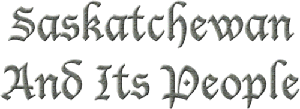THE LISTER KAYE FARMS. (con't)
Another man, who had to do with the cattle buying end of the scheme
was D. H. Andrews. He was an Englishman from Wyoming, an old and
experienced rancher, who was said to have made himself so obnoxious to
the rustlers in that territory that they tried to murder him and he left
to save his life.
Eighteen hundred and eighty-nine was a very dry year and the first
crops failed; no dividends were forthcoming. Grandiose schemes such as
the establishment of an enormous creamery at Swift Current and abatoirs
at Calgary failed to emerge from the atmosphere. The English directors
got tired of pouring money into a seive[sic]. Then Sir John-against whose
personal honor and sincerity no whisper was ever heard-in order to pay
wages, and keep the farms going tried to realise money from the cattle.
A number were slaughtered and the beef sent to Montreal. It didn't meet
with an enthusiastic reception in that market; and the shipment instead of
replenishing the depleted coffers, barely paid expenses. Practically noth-
ing was realised.
At last Sir John had to admit defeat, and returned to England. His
place as general manager was taken by Mr. Thomas Stone, who had been
managing the Kincarth Farm. Mr. Stone was a good business man, a
very fine type of the manly gentleman. Incidentally he was a very fine
sportsman; was once the champion weight-putter in England; a great
pigeon-shot and an all-round good man at English sports. He made a
gallant attempt, but he could not perform impossibilities. The gigantic
wreck was only capable of a little salvaging and Mr. Stone gave up the
task when convinced that successful resuscitation was beyond human
endeavor. Then Mr. D. H. Andrews, the old Wyoming ranchman before
spoken of, took hold in order to make a clean-up of the whole tangled
outfit. Some of the bond-holders were induced to put up another $80,000
and with this sum the property was cleared of all liabilities and these men
became the absolute owners of the land, buildings, machinery, cattle, horses
and sheep-the whole outfit which was estimated to have cost, from first
to last, about a million and a half dollars. They sold the property in lots,
as opportunity arose, and realised a handsome profit.
The disastrous effects of these big failures were manifold. Immigra-
tion was checked, for every old countryman who lost money became a
decrier of the country instead of a "boomster." It also checked the flow
of capital. Conceived in an exaggerated optimism; with no experience
to guide in a new and untried country; taking the basis of one good season,
and making no allowances for the inevitable poor seasons; taking a good
price and making no allowance for possible falling prices, in fact assuming
uninterrupted prosperity, all gain and no loss, promoters were able to
persuade investors that they were in on a sure thing. And they did not
wilfully deceive. They were the victims of their own lack of knowledge.
To give a concrete instance. A man, who is now still a leading farmer in
his district, and who has been on the farm where he now is for forty-one
years, told me that he came in with eastern capital behind him to raise
Bibliography follows:

